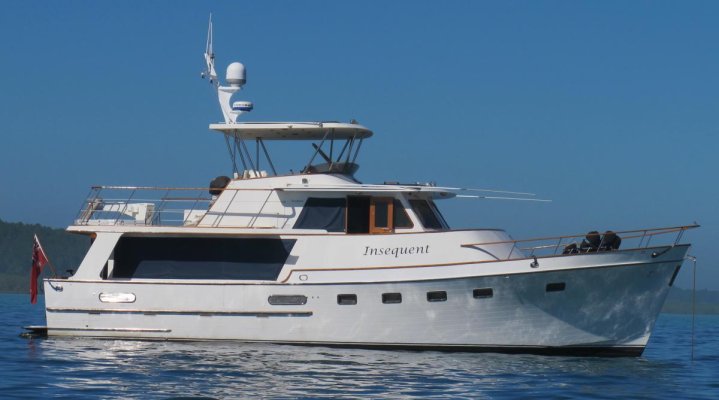- Joined
- Mar 17, 2012
- Messages
- 4,275
- Location
- Australia
- Vessel Name
- Insequent
- Vessel Make
- Ocean Alexander 50 Mk I
I have finally got my new panels setup. Previously I had 7 x 260W Suniva 30V panels. Now I have 6 x 345W Sunpower 60V panels. As I have a 12 V system I have 2 x Outback FlexMax 80's. I really wish I had gone to a 24V house bank as I would only have needed 1 FlexMax. So 3 of the new panels feed each charge controller. In order to have both charge controllers synchronise (in terms of float charging etc) they are linked to a Mate 3 unit.
So far I have not been at anchor or off shore power long enough to get a daily Ah replenishment figure. But a few days ago just before midday I had peak readings of 124.8 A and 1740W. Not too bad for the low angle winter sun! So I think I should get a very healthy amount of Ah during the day. Over the next few weeks I hope to get some data on this.
My new configuration is in part to minimise shading. The 2 panels on the pilothouse roof are 2' further forward to much reduce the effect of shading from the flybridge hardtop. Part of that project necessitated re-positioning the Sat dome. On the hardtop I have just 4 panels located forward. The new mast config involved modifying the deck mounted mast. The lower 5' was discarded and the top half, well top two thirds, mounted on the hardtop. The mast now has the sat dome on the old radar platform with a new radar platform below it. I did not install panels at the aft end of the hardtop near the mast. There would have been shading of them for a lot of the time. As it is the mast only causes some shading when I'm south-facing, but in summer that will be less of an issue as well.
I can lower my VHP antennas to reduce panel shading at anchor. They hinge at the bottom, so its just a 5 second task to raise or lower each antenna. If I get motivated one day at anchor I will try and quantify the shading effect from the antenna, bearing in mind Twisted's warning to allow time for the charge controller to re-scan. Does anyone know how long I would need to wait?
Pic from dingy shows mast, but panels are hard to see as there is only a small airgap between them and the underlying structure. The antennas are lowered. I'll try and remember to take a pic from shore in the morning to actually show the panels themselves before departing on my cruise to points north.
So far I have not been at anchor or off shore power long enough to get a daily Ah replenishment figure. But a few days ago just before midday I had peak readings of 124.8 A and 1740W. Not too bad for the low angle winter sun! So I think I should get a very healthy amount of Ah during the day. Over the next few weeks I hope to get some data on this.
My new configuration is in part to minimise shading. The 2 panels on the pilothouse roof are 2' further forward to much reduce the effect of shading from the flybridge hardtop. Part of that project necessitated re-positioning the Sat dome. On the hardtop I have just 4 panels located forward. The new mast config involved modifying the deck mounted mast. The lower 5' was discarded and the top half, well top two thirds, mounted on the hardtop. The mast now has the sat dome on the old radar platform with a new radar platform below it. I did not install panels at the aft end of the hardtop near the mast. There would have been shading of them for a lot of the time. As it is the mast only causes some shading when I'm south-facing, but in summer that will be less of an issue as well.
I can lower my VHP antennas to reduce panel shading at anchor. They hinge at the bottom, so its just a 5 second task to raise or lower each antenna. If I get motivated one day at anchor I will try and quantify the shading effect from the antenna, bearing in mind Twisted's warning to allow time for the charge controller to re-scan. Does anyone know how long I would need to wait?
Pic from dingy shows mast, but panels are hard to see as there is only a small airgap between them and the underlying structure. The antennas are lowered. I'll try and remember to take a pic from shore in the morning to actually show the panels themselves before departing on my cruise to points north.

